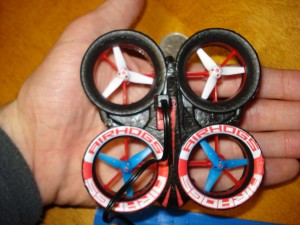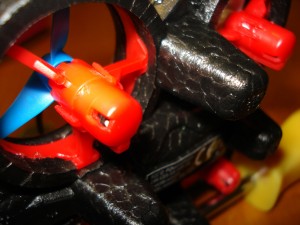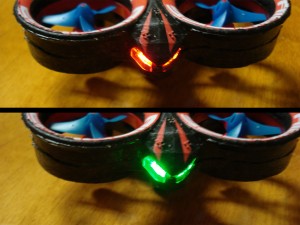I recently bought the Air Hogs “Helix Ion” quadcopter from Wal-Mart. It’s clearly aimed at a younger audience, but a discounted price and unique look made it too hard to pass up. After playing with it for awhile, I figured I’d pass along a few notes for those considering it.
Durability
Listing this first because this is where the Helix Ion really excels. The entire frame of this thing is basically foam, making it pretty much immune to damage from crashes. I’ve crashed the thing over a hundred times now, and the only evidence is the decals that have started to flake off of the foam.
That’s not to say it’ll survive pet teeth, an object that gets jammed in a propeller blade, or a dive into water (although I wouldn’t be surprised if it floated). But crashes – the most common cause of a drone’s demise are something that this thing can take over and over again.
One thing worth noting: There are no spare parts included. So if you somehow do break a propeller blade, you’re out of luck. The blades aren’t a common design, so you’d probably be looking at a call to Air Hog for a replacement.
Controller
The controller uses the most common layout (Mode 2), which is definitely a plus since it makes transitioning to/from other quadcopters really easy. The left stick controls the throttle and yaw (rotating left/right), and the right stick controls the pitch (moving forward/backward) and roll (moving left/right).
There’s a “trick” button on the top right. Unlike the majority of quadcopters that require some sort of button/stick combination to activate, this one is really simple to use: press it, and it does a 360˚ flip in a random direction.
There are a couple “trim” controls also that allow you to correct for unintended drift (4 of the 6 axis). I adjusted them during the first few flights although they’ve stayed fairly stable since.
The drone is supposed to calibrate automatically when turned on and synced to the controller, but if the gyros get out-of-whack after a few crashes, there’s no manual re-calibration sequence that I could find (I tried numerous combinations). It tends to keep it’s calibration pretty well though, so this wasn’t much an of an issue.
There’s a novice/expert switch which pretty much just changes the “headlight” colors to either red or green. Technically, it should affect the flyability (novice being more forgiving, and expert being more twitchy), but I’ll get into that more in the flight section.
On the back is a battery compartment: it’s held on by 2 screws and takes 4x AA batteries.
Flight Handling
I’m not quite sure how I feel about the way it handles, mainly because after the first 2 minutes the battery starts to lose it’s jam fast, making it hard to really fly normally. Here’s the overall gist:
- It’s not twitchy directionally, so should be easier for beginners when it comes to directional movement. The light weight “bulk” of the foam gives it a really “floaty” feel.
- The weight of the unit combined with the small blades makes the throttle (up/down) really touchy and prone to over-correction. In other words, it takes a lot of practise to keep from jetting up into the ceiling or planting down onto the floor when you make a fast vertical correction.
- The yaw (rotate left/right) is fairly slow. No zipping around corners while moving forward, but you’re also not going to lose orientation.
- Because the thing is so durable and bouncy, crashes can be a bit fun.
- If you hit a flat ceiling, the foam will seal against it and create a vacuum – the quad will “stick” to the ceiling even at reduced throttle. You usually have to reduce it so much that it’ll dead-drop, often leading to a floor plant.
- You have about 2 minutes of battery power (from full charge) where you can do flips, hard turns, hard acceleration, and fly somewhat aggressively. After that, it starts to get a little more unresponsive/clunky, getting worse and worse until the end. By the 4 minute mark, the battery is usually so sapped that it’s not responsive enough to correct any hard momentum, and trying to maintain altitude during any directional movement becomes a challenge.
For a beginner, the directional movement is pretty good – you’re not as likely to go flying across the room sideways into a wall, and corrections are pretty easy (during the first couple minutes when the battery is good, anyway).
The vertical on the other hand (throttle) is on the poor side. When the battery is good, it’s easy to jet into a ceiling. When the battery is getting weak (in the 2-4 minute range), you start to run into the opposite problem – it just doesn’t have the power to accelerate “up” fast enough to recover from a quick down motion.
Overall, it’s pretty fun to fly although a lot of that stems from the ability to mindlessly crash into things without worry. It’s pretty precise directionally at low speeds, but not as nimble as other quads when you really start moving – any momentum really has a big impact and when the battery starts it’s early nosedive in power, the Helix Ion starts to feel downright clunky. The inconsistent vertical/throttle can get frustrating at times, particularly because it flies so much differently on a fresh charge compared to half way through.
Battery
A 3.7 volt 140mAH LiPo battery is built in. Depending on how aggressively you fly it, it gives about 4-7 minutes of flight time. Over the final 30 seconds or so, it will slowly descend even at full throttle. The low battery flash will usually happen right around the time it’s lost so much “oomph” that it’s on the ground anyway.
It would definitely have benefitted from a stronger battery. If brand new you’re only getting 2 mins of real oomph, you can bet that in a few months the thing won’t have any oomph left in it.
Charging
The Helix Ion charges pretty conveniently from the controller (which uses 4x AA batteries). There’s a little compartment that contains the charging cable which plugs right into the quadcopter. The controller has some “smart” charging circuitry in there along with visual indicators: it blinks red while charging, and turns green once the quad is fully charged – usually in under 20 minutes.
The main downside is that it’ll obviously eat through AA batteries more quickly since they’re used for the controller and for charging up the quad. While you can plug a Micro USB cable into the controller for charging:
- The Micro USB cable isn’t included.
- The cable just applies 4.5-4.6v to the battery terminals (which then charges the quad): since the batteries already add up to 6 volts (4x AA batteries which are 1.5 volts each), the higher-voltage batteries will still be drained anyway. The USB cable will only help charge the quad if your batteries are weak enough to cause them to drop below 1.1 volts each during charge (4.5v combined), at which point they’re probably getting close to being dead anyway.
- If you don’t use rechargeable batteries, the cable will try charging your non-rechargable batteries if they get below 1.1 volts, possibly causing them to leak. An interesting warning from the manual: it says not to use rechargable batteries, but also says not to charge non-rechargables (interesting because if you plug in a USB cable with the batteries still in, you’re automatically violating 1 of the 2 warnings no matter what battery type you use).
A little added circuitry could have allowed a MicroUSB cable to work really well (either just charging the quad, or charging the quad plus rechargable AA’s), but evidently Air Hogs wasn’t terribly interested in the MicroUSB charging functionality except as a paper feature – probably why they didn’t include the cable to begin with.
It’s worth noting that if you want to use the cable to charge the quad without draining the batteries, you can remove the batteries first and then hook up the cable, since the cable just applies power to those battery terminals anyway. It’s extremely inconvenient, but I did try it and it works. You will probably have to press the power button on the controller for it to detect that it’s plugged into the quad though.
Final Thoughts
There’s huge value in being able to crash a quadcopter hundreds of times with minimal risk of damage. I can see the Helix Ion being a great fit for anyone flying indoors for the first time and especially great for family/friend get-togethers where nearly any quad is destined to take a beating. Because it uses the common Mode 2 controls, anyone who “learns the ropes” on it should have an easy time transitioning to other quads.
The 1-button-random-trick (limited, but simple) and charge-from-controller features may be either pros or cons depending on your personal preference.
I only used it indoors, but suspect that it wouldn’t fare well outdoors with even the slightest breeze. It’s just way too floaty without a lot of engine/battery power to handle wind.
Finally, once the battery’s gone soft within 2-4 minutes, it’s a little like trying to drive a car that’s running out of gas while the lugnuts are starting to be loosened off… It’s really the one big downside. For that reason, it’s a quad that I suspect most people will tire of pretty quickly, yet will still keep around so that they have something durable on hand when guests come by and want to try their hand at flying.






